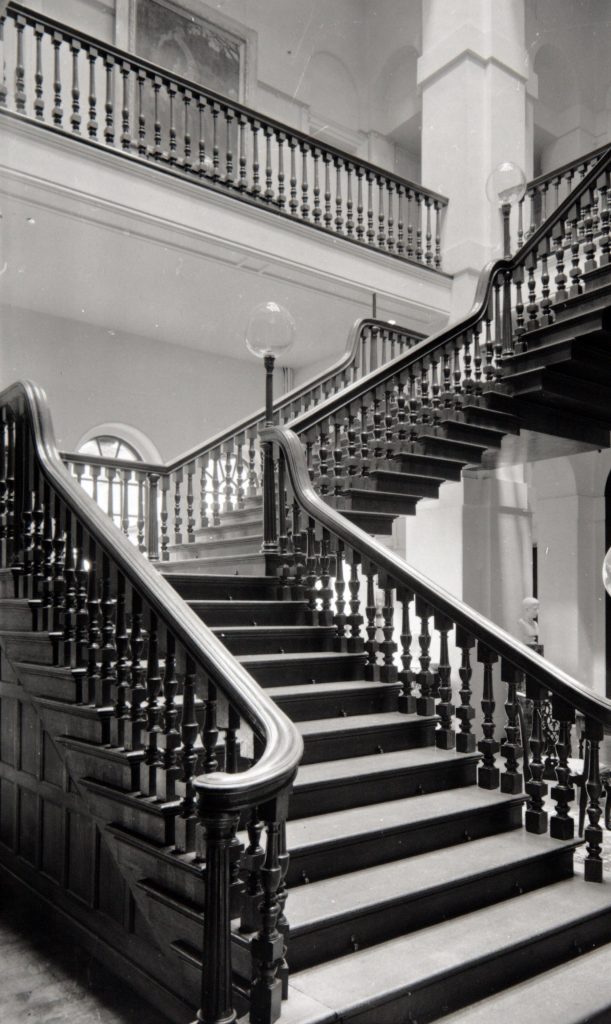There were strong connections between Kings Weston and Ireland, ever since the estate was bought by Robert Southwell in 1679. Southwell was from a wealth Irish family and was appointed Secretary of State for Ireland by the King. His descendants maintained and strengthened their Irish roots, adding extensive landholdings, marrying into illustrious Irish families, and maintaining the role of Secretary of State through several generations. The Southwell’s’ built extensively on their estates, introducing the latest styles, and during the Georgian era Kings Weston became a frequent staging post for many travellers between the two kingdoms. Perhaps it’s not surprising that Kings Weston might have influenced the direction of architecture in Ireland.
Edward Lovett Pearce is, perhaps, Ireland’s most important 18th Century architect. He was from an Irish family and cousin of Sir John Vanbrugh. Recent research suggests that he worked closely as apprentice to the great architect at Kings Weston. Robert Lynch has identified a striking and idiosyncratic detail of the great stair at Kings Weston repeated in many of Lovett Pearce’s later works: the unusual continuous swan-neck curve of the balustrade handrail, passing continuously up the stair to the landings.

Right: Another of Pearce’s stair designs at Desart Court, County Kilkenny of 1733, since destroyed.

Pearce had become a pupil of Vanbrugh in 1715, following the death of his father, and undoubtedly would have dealt with work at Kings Weston, then in construction. Work on the great staircase is known to have been continuing in 1719, three years after the Southwell’s’ moved into their new mansion, but designs are likely to have been fixed before 1717 when Pearce chose a short-lived career in the dragoons. He may have returned to architecture in around 1722 when Vanbrugh and Southwell had already turned their attention to the Kings Weston parkland, ornamenting it with new ornamental garden buildings.

By chance the “temple” at Emo Court in County Laois caught our attention. It’s not really a temple, but a gateway and gloriette. There’s little evidence dating it. But there’s something familiar about its shape; it bears some resemblance to Penpole Lodge at Kings Weston. A rusticated podium, a central arch with arch and circle recesses either side, a single small room sat crowning the arch, and each accessed by a cramped staircase threaded up through one of the side piers are some of the features shared between the two buildings. Like Kings Weston the Emo Court building was strategically located for picturesque effect from the house it once belonged to. Exploiting a highpoint in its parkland, like Penpole, it would have been silhouetted as a landmark on the horizon, with the arch framing views of open sky from the mansion house, since rebuilt.
With the kind assistance of the Ministry of Works in Ireland we’ve got access to measured drawings of the now ruined Emo Court arch, and have drawn up a simple 3D model to compare with our one of the original Penpole Lodge. Marginally smaller, it’s still not too dissimilar in character from Penpole to be able to suggest some sort of kinship.

The designs of Penpole Lodge are dated 1724. It was in this year that Edward Lovett Pearce is believed to have returned to Ireland to begin his own practice and meteoric rise in Irish society. The Irish Georgian Society has tentatively connected Pearce’s name with the Emo Court building, and architectural historian James Horley has made stylistic comparisons between it and other of his works. Regardless of its authorship there are stylistic, political, and logistical reasons to believe that Penpole Lodge might have been the inspiration for Emo Court. Circumstantial evidence for this is strengthened where Pearce’s involvement at Kings Weston is brought into consideration, and a possible direct route for the importation of architectural ideas into Ireland.

Bottom: Penpole Point and Lodge, detail of a painting circa 1760. (Sir John Soane’s museum)


